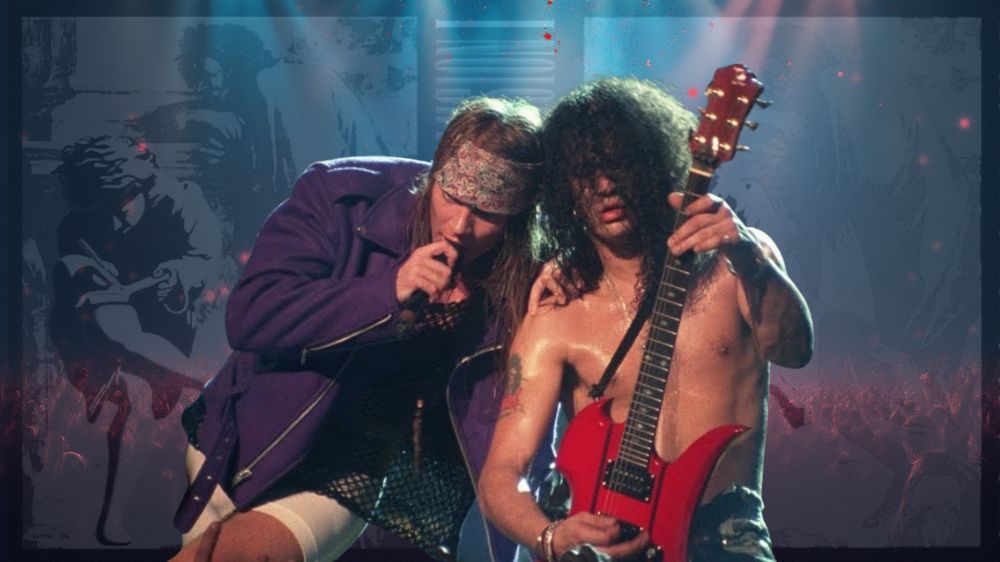In September 1991, against a backdrop of shifting cultural currents and mounting global tensions, Guns N’ Roses released their ambitious double album, Use Your Illusion I and II. Emerging from the raw, streetwise ferocity that had defined their 1987 debut, Appetite for Destruction, the Los Angeles quintet fronted by Axl Rose with Slash’s incendiary guitar lines, Duff McKagan’s rhythmic drive, Izzy Stradlin’s melodic sensibilities and Matt Sorum’s percussive precision, embraced a broader artistic vision that amplified their signature blend of punk attitude and blues-inflected hard rock while venturing into symphonic landscapes, introspective balladry and socially charged commentary.
The first disc, Use Your Illusion I, foregrounds the band’s expanding musical palette: piano-driven power-ballads, orchestrated arrangements and divergent production techniques signal Guns N’ Roses’ willingness to defy genre conventions. Conversely, Use Your Illusion II channels a darker, edgier tone, balancing pointed protest songs and riff-heavy anthems with the same epic scope. Taken together, the albums reflect a band at a crossroads, capitalising on their newfound fame while wrestling with internal tensions, personal demons and the evolving demands of the rock marketplace.
Ultimately, Use Your Illusion I and II occupy a singular place in rock history. They chart Guns N’ Roses’ transition from rough-hewn outsiders to global superstars unafraid to test the limits of their craft. By juxtaposing blistering aggression with orchestral grandeur and personal confession with political critique, the double album crystallises both the promise and the perils of early ’90s rock. This article will analyse five pivotal tracks that illuminate the albums’ artistic breadth and enduring resonance.
You Could Be Mine
From its opening salvo of throttling guitar to Axl Rose’s snarled promise of romantic volatility, “You Could Be Mine” embodies unrestrained aggression. Conceived during the Appetite for Destruction sessions but only realised fully for Use Your Illusion II, the song found its widest audience via its role in Terminator 2: Judgment Day. Schwarzenegger’s personal endorsement afforded it crossover success, propelling the single to number three on the UK Singles Chart and into the US Top 30. Studio anecdotes tell of the riff slashing into existence under Slash’s deft fingers, while Axl’s verses, peppered with barbed references to “cocaine tongue”, hark back to forgotten liner-note quips from 1987. In marrying blockbuster cinema to hard-rock ferocity, the track set the tone for a double album bristling with ambition.
Civil War
A measured critique of armed conflict, “Civil War” opens Use Your Illusion II with a mournful haze of strings before drifting into a churning, protest-laden riff. Its gestation began years earlier, in sound-checks and benefit compilations, but only in Melbourne did Axl fashion lyrics that evoke both historical strife and personal recollections. Duff McKagan later recalled how a childhood peace march, including his mother and a four-year-old Duff himself, inspired the now-iconic line about black armbands and Martin Luther King’s dream of everlasting peace. Released as a single in 1993, the song topped charts in Poland and Spain, and served as the final Guns N’ Roses single featuring founding drummer Steven Adler before his departure.
Don’t Cry
The melancholic undercurrent that propels “Don’t Cry” belies its title. Co-written in 1985 by Axl Rose and Izzy Stradlin, the ballad emerged from months of personal strife between the pair. Legend has it that Axl stormed Stradlin’s home, hurling pebbles at his window until the two reconciled in a fit of creative desperation. The result is two subtly different mixes on Use Your Illusion I and II, each accentuating Shannon Hoon’s ethereal backing vocals above Axl’s earnest lament. Its layered guitars and tear-stained piano underscore the power-ballad form at its most heart-rending, conveying raw feeling rather than contrived showmanship.
Estranged
With neither verse-chorus-verse structure nor succinct runtime, “Estranged” stretches over nine minutes of shifting moods and instrumental odysseys. Written in the aftermath of Axl’s broken engagement to Erin Everly, the composition reads as a confessional journey through isolation and regret. Slash’s solo, recorded on a Les Paul Gold Top with tone knobs dialled to a glassy resonance, veer from fragile reminiscence to frenetic catharsis. Between swelling piano motifs and cyclical guitar refrains, the song eschews traditional pop formulas in favour of an epic scope, mirroring both personal exile and artistic liberation.
November Rain
Few power-ballads of the rock canon compare to the sweeping drama of “November Rain.” First sketched in 1983 and initially sprawling over eighteen minutes, the track was pruned and polished for its nine-minute album incarnation. Axl Rose’s piano work nods unmistakably to Elton John, overlaid with orchestral swells and a signature Slash solo that ascends like a cathedral of sound. Upon its 1992 single release, “November Rain” reached number three on the US charts, the longest song ever to break the Top 10 at the time, and achieved similar acclaim in Britain. Its lavish music video, filmed amid desert canyons and rain-soaked chapels, underscored the song’s themes of loss and endurance and remains one of the most extravagant productions in rock history.
Finale of an Era
These five tracks, from the snarling aggression of “You Could Be Mine” to the sweeping heartbreak of “November Rain”, capture Guns N’ Roses at their most daring. They take the raw spirit of late-’80s rock, stretch it through orchestral swells and personal confessions, then land it squarely on the listener’s emotions. Along the way, the band confronts war, failed romances and the price of fame without ever losing its edge. Use Your Illusion I & II might have sprawled across two discs, but these songs prove there was method in the madness. Decades later, their power hasn’t faded. If anything, it’s grown, reminding us that great music isn’t just heard, it’s felt.
